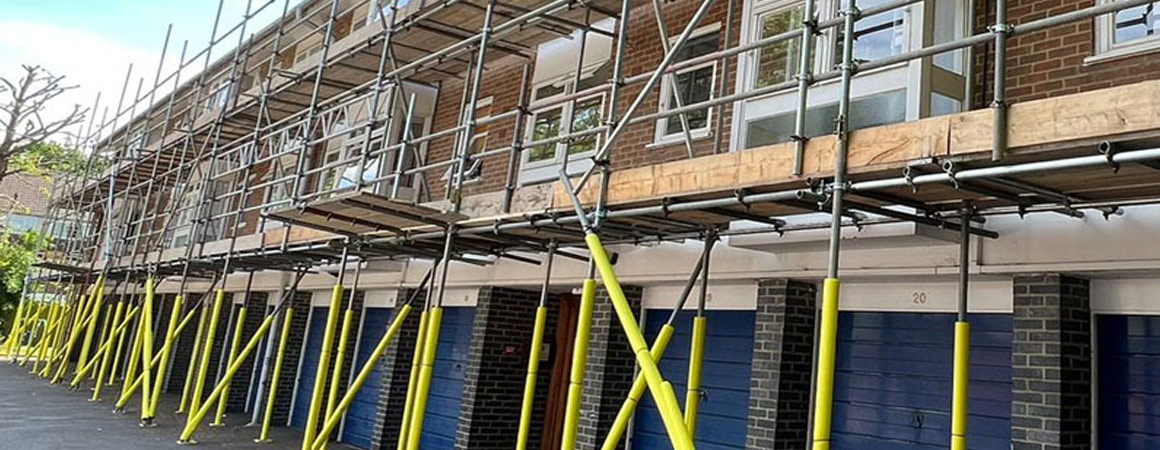If scaffolding isn’t inspected properly, it becomes a serious risk. Components may be damaged, incorrectly assembled or missing entirely, any one of which can lead to collapse. That’s why the Work at Height Regulations 2005 set out strict inspection requirements.
This article explains when those inspections must happen, what they should cover and who’s responsible for carrying them out.
How Often Should Scaffolding Be Inspected?
If you’re responsible for a site that uses scaffolding, whether you’re the contractor, site manager or the person who arranged the hire, inspections aren’t optional.
Under the Work at Height Regulations 2005, scaffolding must be inspected:
✓ After it’s been put up and before anyone uses it
✓ At least once every seven days
✓ After anything that could affect its stability, like strong winds, alterations or accidental damage
Seven days is the maximum allowed between inspections, but if there’s been an issue, it must be checked again, no matter when the last inspection was done.
It doesn’t matter if the scaffold looks fine, if it’s been exposed to risk, it’s not safe to assume it still is.
Who Is Responsible for Scaffolding Inspections?
The site manager or principal contractor is legally responsible for ensuring scaffolding is inspected. However, inspections must be carried out by a competent person, someone with the necessary training, knowledge and experience to identify safety issues. In many cases, this means a qualified scaffolding inspector or a certified member of the construction team.
Scaffold Legal Requirements and Regulations UK
Let’s look at this in more detail. There are a few UK scaffolding regulations and if it is used on your site, you’re legally responsible for ensuring it’s inspected and documented correctly.
The Work at Height Regulations 2005 (Regulation 12) requires:
- Inspections carried out by a competent person, someone with the training and experience to spot safety issues
- A written inspection report within 24 hours of each check
- Reports are to be kept on site while the scaffold is in place and retained for three months after it’s dismantled
If the scaffold extends over a public road or footpath, you’ll usually need a permit from the local authority, which may also include extra inspection requirements.
And keep in mind that the Health and Safety Executive has the power to inspect your site at any time. So if you’re not meeting the inspection requirements, they can stop the job, issue notices or take legal action, especially if someone is injured or the scaffold fails.
What Should Be Checked During an Inspection?
A proper scaffolding inspection isn’t just a quick once-over visual check. The HSE outlines clear expectations for what should be included.
Here’s what the inspection should cover:
- Base and foundations – The scaffold must be level, stable and resting on firm ground or suitable base plates and sole boards
- Standards, ledgers and transoms – Check for bends, cracks, loose fittings and correct spacing
- Bracing – Diagonal and sway braces should be in place and fixed securely
- Ties and anchors – Ensure the scaffold is properly tied to the structure at correct intervals
- Platforms and boards – Boards should be secure, level and without splits or excessive wear
- Guardrails and toe boards – These must be fitted at all working platforms to prevent falls and falling objects
- Access points – Ladders or stair towers must be secure, in good condition and positioned correctly
- Edge protection – Check for missing rails, gaps or anything that could allow a fall
- Weather protection and netting – If fitted, these should be secure and not affecting stability
- Load limits – Make sure the scaffold hasn’t been overloaded beyond its intended use
- Signs of tampering or damage – Look for anything that’s been moved, removed or knocked
Know the Scaffolding Inspection Rules
To recap, scaffolding must be inspected before use, every seven days and after anything that could affect its safety. And remember, it’s a legal requirement, not a guideline.
If you’re responsible for the site, it’s your job to make sure those checks happen and that they’re done properly and recorded.
Not sure if your setup meets the standard? Speak to a qualified scaffolding contractor because it’s not worth the risk.
